
Illustrative Math Alignment: Grade 7 Unit 7
Expressions, Equations, and Inequalities
Lesson 5: Reasoning about Equations and Tape Diagrams (Part 2)
Use the following Media4Math resources with this Illustrative Math lesson.
| Thumbnail Image | Title | Body | Curriculum Topic |
|---|---|---|---|

|
Math Clip Art--Rates and Tape Diagrams: Cooking 7 | Math Clip Art--Rates and Tape Diagrams: Cooking 7 This is a collection of clip art images that show how to use tape diagrams to solve ratio and rate problems. |
Ratios and Rates |

|
Math Clip Art--Rates and Tape Diagrams: Cooking 7 | Math Clip Art--Rates and Tape Diagrams: Cooking 7 This is a collection of clip art images that show how to use tape diagrams to solve ratio and rate problems. |
Ratios and Rates |

|
Math Clip Art--Rates and Tape Diagrams: Cooking 8 | Math Clip Art--Rates and Tape Diagrams: Cooking 8 This is a collection of clip art images that show how to use tape diagrams to solve ratio and rate problems. |
Ratios and Rates |

|
Math Clip Art--Rates and Tape Diagrams: Cooking 8 | Math Clip Art--Rates and Tape Diagrams: Cooking 8 This is a collection of clip art images that show how to use tape diagrams to solve ratio and rate problems. |
Ratios and Rates |
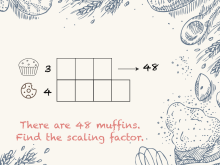
|
Math Clip Art--Rates and Tape Diagrams: Cooking 9 | Math Clip Art--Rates and Tape Diagrams: Cooking 9 This is a collection of clip art images that show how to use tape diagrams to solve ratio and rate problems. |
Ratios and Rates |

|
Math Clip Art--Rates and Tape Diagrams: Cooking 9 | Math Clip Art--Rates and Tape Diagrams: Cooking 9 This is a collection of clip art images that show how to use tape diagrams to solve ratio and rate problems. |
Ratios and Rates |

|
Math Example: Solving One-Step Equations Using the Properties of Equality--Example 1 | Math Example: Solving One-Step Equations Using the Properties of Equality--Example 1
This is part of a collection of math examples that show how to solve one-step equations that include addition, subtraction, multiplication, or division. |
Solving One-Step Equations |
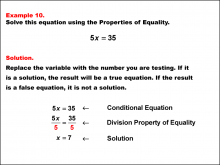
|
Math Example: Solving One-Step Equations Using the Properties of Equality--Example 10 | Math Example: Solving One-Step Equations Using the Properties of Equality--Example 10
This is part of a collection of math examples that show how to solve one-step equations that include addition, subtraction, multiplication, or division. |
Solving One-Step Equations |
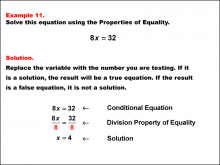
|
Math Example: Solving One-Step Equations Using the Properties of Equality--Example 11 | Math Example: Solving One-Step Equations Using the Properties of Equality--Example 11
This is part of a collection of math examples that show how to solve one-step equations that include addition, subtraction, multiplication, or division. |
Solving One-Step Equations |
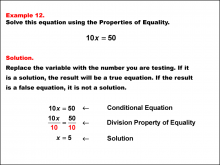
|
Math Example: Solving One-Step Equations Using the Properties of Equality--Example 12 | Math Example: Solving One-Step Equations Using the Properties of Equality--Example 12
This is part of a collection of math examples that show how to solve one-step equations that include addition, subtraction, multiplication, or division. |
Solving One-Step Equations |

|
Math Example: Solving One-Step Equations Using the Properties of Equality--Example 2 | Math Example: Solving One-Step Equations Using the Properties of Equality--Example 2
This is part of a collection of math examples that show how to solve one-step equations that include addition, subtraction, multiplication, or division. |
Solving One-Step Equations |
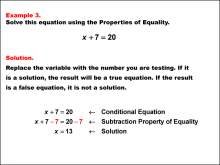
|
Math Example: Solving One-Step Equations Using the Properties of Equality--Example 3 | Math Example: Solving One-Step Equations Using the Properties of Equality--Example 3
This is part of a collection of math examples that show how to solve one-step equations that include addition, subtraction, multiplication, or division. |
Solving One-Step Equations |
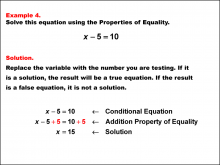
|
Math Example: Solving One-Step Equations Using the Properties of Equality--Example 4 | Math Example: Solving One-Step Equations Using the Properties of Equality--Example 4
This is part of a collection of math examples that show how to solve one-step equations that include addition, subtraction, multiplication, or division. |
Solving One-Step Equations |

|
Math Example: Solving One-Step Equations Using the Properties of Equality--Example 5 | Math Example: Solving One-Step Equations Using the Properties of Equality--Example 5
This is part of a collection of math examples that show how to solve one-step equations that include addition, subtraction, multiplication, or division. |
Solving One-Step Equations |
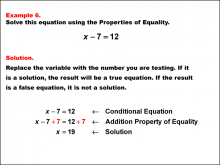
|
Math Example: Solving One-Step Equations Using the Properties of Equality--Example 6 | Math Example: Solving One-Step Equations Using the Properties of Equality--Example 6
This is part of a collection of math examples that show how to solve one-step equations that include addition, subtraction, multiplication, or division. |
Solving One-Step Equations |
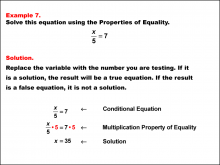
|
Math Example: Solving One-Step Equations Using the Properties of Equality--Example 7 | Math Example: Solving One-Step Equations Using the Properties of Equality--Example 7
This is part of a collection of math examples that show how to solve one-step equations that include addition, subtraction, multiplication, or division. |
Solving One-Step Equations |
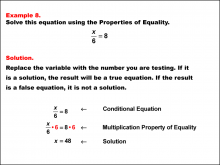
|
Math Example: Solving One-Step Equations Using the Properties of Equality--Example 8 | Math Example: Solving One-Step Equations Using the Properties of Equality--Example 8
This is part of a collection of math examples that show how to solve one-step equations that include addition, subtraction, multiplication, or division. |
Solving One-Step Equations |

|
Math Example: Solving One-Step Equations Using the Properties of Equality--Example 9 | Math Example: Solving One-Step Equations Using the Properties of Equality--Example 9
This is part of a collection of math examples that show how to solve one-step equations that include addition, subtraction, multiplication, or division. |
Solving One-Step Equations |
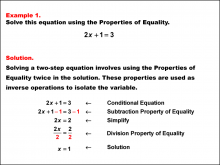
|
Math Example: Solving Two-Step Equations Using the Properties of Equality--Example 1 | Math Example: Solving Two-Step Equations Using the Properties of Equality--Example 1
This is part of a collection of math examples that show how to solve two-step equations that involve combinations of addition, subtraction, multiplication, and division. |
Solving Two-Step Equations |
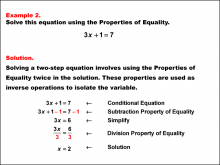
|
Math Example: Solving Two-Step Equations Using the Properties of Equality--Example 2 | Math Example: Solving Two-Step Equations Using the Properties of Equality--Example 2
This is part of a collection of math examples that show how to solve two-step equations that involve combinations of addition, subtraction, multiplication, and division. |
Solving Two-Step Equations |
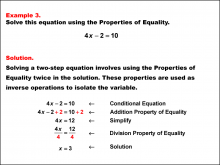
|
Math Example: Solving Two-Step Equations Using the Properties of Equality--Example 3 | Math Example: Solving Two-Step Equations Using the Properties of Equality--Example 3
This is part of a collection of math examples that show how to solve two-step equations that involve combinations of addition, subtraction, multiplication, and division. |
Solving Two-Step Equations |

|
Math Example: Solving Two-Step Equations Using the Properties of Equality--Example 4 | Math Example: Solving Two-Step Equations Using the Properties of Equality--Example 4
This is part of a collection of math examples that show how to solve two-step equations that involve combinations of addition, subtraction, multiplication, and division. |
Solving Two-Step Equations |
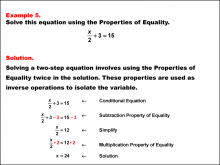
|
Math Example: Solving Two-Step Equations Using the Properties of Equality--Example 5 | Math Example: Solving Two-Step Equations Using the Properties of Equality--Example 5
This is part of a collection of math examples that show how to solve two-step equations that involve combinations of addition, subtraction, multiplication, and division. |
Solving Two-Step Equations |

|
Math Example: Solving Two-Step Equations Using the Properties of Equality--Example 6 | Math Example: Solving Two-Step Equations Using the Properties of Equality--Example 6
This is part of a collection of math examples that show how to solve two-step equations that involve combinations of addition, subtraction, multiplication, and division. |
Solving Two-Step Equations |
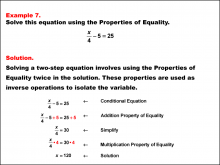
|
Math Example: Solving Two-Step Equations Using the Properties of Equality--Example 7 | Math Example: Solving Two-Step Equations Using the Properties of Equality--Example 7
This is part of a collection of math examples that show how to solve two-step equations that involve combinations of addition, subtraction, multiplication, and division. |
Solving Two-Step Equations |
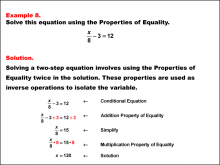
|
Math Example: Solving Two-Step Equations Using the Properties of Equality--Example 8 | Math Example: Solving Two-Step Equations Using the Properties of Equality--Example 8
This is part of a collection of math examples that show how to solve two-step equations that involve combinations of addition, subtraction, multiplication, and division. |
Solving Two-Step Equations |
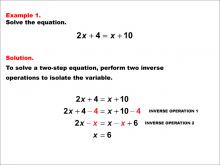
|
Math Example: Solving Two-Step Equations: Example 1 | Math Example: Solving Two-Step Equations: Example 1TopicSolving Equations DescriptionThis example demonstrates how to solve the two-step equation 2x + 4 = x + 10. The solution process involves subtracting 4 from both sides of the equation, then subtracting x from both sides to isolate the variable. Through these steps, we find that x = 6. Solving two-step equations is a fundamental skill in algebra. These equations typically involve two operations to isolate the variable, such as addition/subtraction and multiplication/division. This collection of examples helps teach this topic by presenting a variety of equation types, allowing students to recognize patterns and develop problem-solving strategies. |
Solving Two-Step Equations |
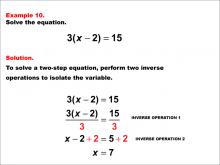
|
Math Example: Solving Two-Step Equations: Example 10 | Math Example: Solving Two-Step Equations: Example 10TopicSolving Equations DescriptionThis example demonstrates solving the equation 3(x - 2) = 15. The solution process involves first dividing both sides of the equation by 3, then adding 2 to both sides to isolate the variable. Through these steps, we find that x = 7. |
Solving Two-Step Equations |
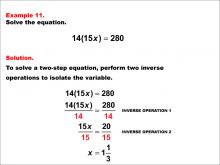
|
Math Example: Solving Two-Step Equations: Example 11 | Math Example: Solving Two-Step Equations: Example 11TopicSolving Equations DescriptionThis example demonstrates solving the equation 14(15x) = 280. The solution process involves dividing both sides of the equation by 14, then dividing by 15 to isolate the variable. Through these steps, we find that x = 1 1/3. |
Solving Two-Step Equations |

|
Math Example: Solving Two-Step Equations: Example 12 | Math Example: Solving Two-Step Equations: Example 12TopicSolving Equations DescriptionThis example demonstrates solving the equation 12(x/5) = 144. The solution process involves dividing both sides of the equation by 12, then multiplying by 5 to isolate the variable. Through these steps, we find that x = 60. |
Solving Two-Step Equations |
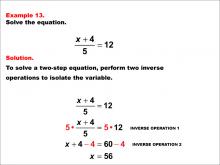
|
Math Example: Solving Two-Step Equations: Example 13 | Math Example: Solving Two-Step Equations: Example 13TopicSolving Equations DescriptionThis example demonstrates solving the equation (x + 4) / 5 = 12. The solution process involves multiplying both sides of the equation by 5, then subtracting 4 from both sides to isolate the variable. Through these steps, we find that x = 56. |
Solving Two-Step Equations |

|
Math Example: Solving Two-Step Equations: Example 14 | Math Example: Solving Two-Step Equations: Example 14TopicSolving Equations DescriptionThis example demonstrates solving the equation (x - 4) / 5 = 12. The solution process involves multiplying both sides of the equation by 5, then adding 4 to both sides to isolate the variable. Through these steps, we find that x = 64. |
Solving Two-Step Equations |
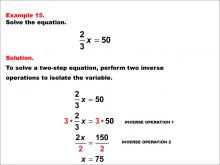
|
Math Example: Solving Two-Step Equations: Example 15 | Math Example: Solving Two-Step Equations: Example 15TopicSolving Equations DescriptionThis example demonstrates solving the equation (2/3)x = 50. The solution process involves multiplying both sides of the equation by 3, then dividing both sides by 2 to isolate the variable. Through these steps, we find that x = 75. |
Solving Two-Step Equations |
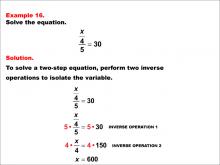
|
Math Example: Solving Two-Step Equations: Example 16 | Solving Two-Step Equations: Example 16TopicSolving Equations DescriptionThis math example demonstrates how to solve the equation ( x / 4 ) / 5 = 30. The solution involves multiplying both sides by 5, then multiplying by 4 to isolate x. The final result is x = 600. Solving two-step equations is a fundamental skill in algebra. This collection of examples helps teach this topic by presenting various equation formats, including fractions and negative numbers. By working through these diverse problems, students can develop a comprehensive understanding of the steps required to solve different types of two-step equations. |
Solving Two-Step Equations |
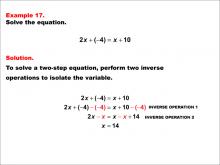
|
Math Example: Solving Two-Step Equations: Example 17 | Solving Two-Step Equations: Example 17TopicSolving Equations DescriptionThis math example illustrates the process of solving the equation 2x + ( -4 ) = x + 10. The solution involves subtracting ( -4 ) and x from both sides of the equation to isolate x. After performing these operations, we find that x = 14. |
Solving Two-Step Equations |
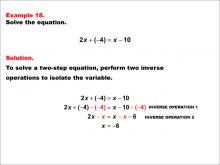
|
Math Example: Solving Two-Step Equations: Example 18 | Solving Two-Step Equations: Example 18TopicSolving Equations DescriptionThis math example demonstrates the process of solving the equation 2x + ( -4 ) = x - 10. The solution involves subtracting ( -4 ) and x from both sides of the equation to isolate x. After performing these operations, we find that x = -6. |
Solving Two-Step Equations |
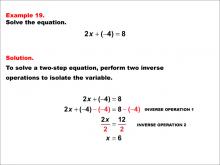
|
Math Example: Solving Two-Step Equations: Example 19 | Solving Two-Step Equations: Example 19TopicSolving Equations DescriptionThis math example illustrates the process of solving the equation 2x + ( -4 ) = 8. The solution involves adding ( -4 ) to both sides and then dividing by 2 to isolate x. After performing these operations, we find that x = 6. |
Solving Two-Step Equations |
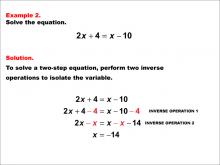
|
Math Example: Solving Two-Step Equations: Example 2 | Math Example: Solving Two-Step Equations: Example 2TopicSolving Equations DescriptionIn this example, we solve the equation 2x + 4 = x - 10. The solution process involves subtracting 4 from both sides of the equation, then subtracting x from both sides. Through these steps, we find that x = -14. |
Solving Two-Step Equations |
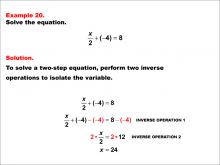
|
Math Example: Solving Two-Step Equations: Example 20 | Solving Two-Step Equations: Example 20TopicSolving Equations DescriptionThis math example demonstrates how to solve the equation x / 2 + ( -4 ) = 8. The solution involves adding ( -4 ) to both sides and then multiplying by 2 to isolate x. After performing these operations, we find that x = 24. |
Solving Two-Step Equations |
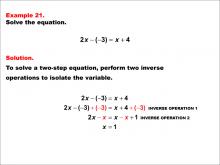
|
Math Example: Solving Two-Step Equations: Example 21 | Math Example: Solving Two-Step Equations: Example 21TopicSolving Equations DescriptionThis math example demonstrates solving the equation 2x - (-3) = x + 4. The solution involves adding -3 to both sides and then subtracting x from both sides to isolate the variable. The final result is x = 1. This example showcases the process of solving a two-step equation with negative numbers. |
Solving Two-Step Equations |

|
Math Example: Solving Two-Step Equations: Example 22 | Math Example: Solving Two-Step Equations: Example 22TopicSolving Equations DescriptionThis math example illustrates the process of solving the equation 2x - (-3) = x - 4. The solution involves adding -3 to both sides and then subtracting x from both sides to isolate the variable. The final result is x = -7. This example demonstrates how to handle negative numbers and subtraction in two-step equations. |
Solving Two-Step Equations |
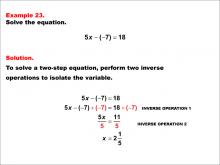
|
Math Example: Solving Two-Step Equations: Example 23 | Math Example: Solving Two-Step Equations: Example 23TopicSolving Equations DescriptionThis math example demonstrates solving the equation 5x - (-7) = 18. The solution involves adding -7 to both sides and then dividing by 5 to isolate the variable x. The final result is x = 2 1/5 or 2.2. This example showcases how to handle negative numbers and fractions in two-step equations. |
Solving Two-Step Equations |
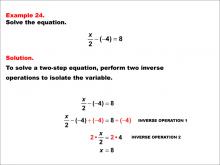
|
Math Example: Solving Two-Step Equations: Example 24 | Math Example: Solving Two-Step Equations: Example 24TopicSolving Equations DescriptionThis math example illustrates the process of solving the equation x/2 - (-4) = 8. The solution involves adding -4 to both sides and then multiplying by 2 to isolate the variable x. The final result is x = 8. This example demonstrates how to handle fractions and negative numbers in two-step equations. |
Solving Two-Step Equations |
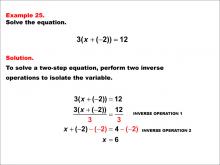
|
Math Example: Solving Two-Step Equations: Example 25 | Math Example: Solving Two-Step Equations: Example 25TopicSolving Equations DescriptionThis math example demonstrates solving the equation 3(x + (-2)) = 12. The solution involves first dividing both sides by 3 to isolate the expression x + (-2), then adding 2 to both sides to isolate x. The final result is x = 6. This example showcases how to handle parentheses and negative numbers in two-step equations. |
Solving Two-Step Equations |
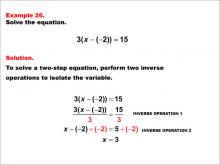
|
Math Example: Solving Two-Step Equations: Example 26 | Math Example: Solving Two-Step Equations: Example 26TopicSolving Equations DescriptionThis math example illustrates the process of solving the equation 3(x - (-2)) = 15. The solution involves first dividing both sides by 3 to isolate the expression x - (-2), then subtracting 2 from both sides to isolate x. The final result is x = 3. This example demonstrates how to handle parentheses and double negatives in two-step equations. |
Solving Two-Step Equations |

|
Math Example: Solving Two-Step Equations: Example 27 | Math Example: Solving Two-Step Equations: Example 27TopicSolving Equations DescriptionThis math example demonstrates solving the equation 14(-15x) = 280. The solution involves first dividing both sides by 14 to isolate the expression -15x, then dividing by -15 to isolate x. The final result is x = -1/3. This example showcases how to handle multiplication with negative numbers and fractions in two-step equations. |
Solving Two-Step Equations |
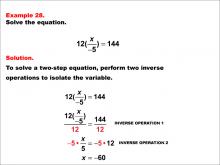
|
Math Example: Solving Two-Step Equations: Example 28 | Math Example: Solving Two-Step Equations: Example 28TopicSolving Equations DescriptionThis math example illustrates the process of solving the equation 12(x/-5) = 144. The solution involves first dividing both sides by 12 to isolate the expression x/-5, then multiplying by 5 to isolate x. The final result is x = -60. This example demonstrates how to handle fractions and multiplication in two-step equations. |
Solving Two-Step Equations |

|
Math Example: Solving Two-Step Equations: Example 29 | Math Example: Solving Two-Step Equations: Example 29TopicSolving Equations DescriptionThis math example demonstrates solving the equation (x + (-4)) / 5 = 12. The solution involves first multiplying both sides by 5 to isolate the expression x + (-4), then adding 4 to isolate x. The final result is x = 64. This example showcases how to handle fractions and negative numbers in two-step equations. |
Solving Two-Step Equations |
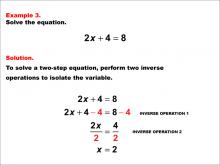
|
Math Example: Solving Two-Step Equations: Example 3 | Math Example: Solving Two-Step Equations: Example 3TopicSolving Equations DescriptionThis example demonstrates solving the equation 2x + 4 = 8. The solution process involves subtracting 4 from both sides of the equation, then dividing both sides by 2. Through these steps, we find that x = 2. |
Solving Two-Step Equations |
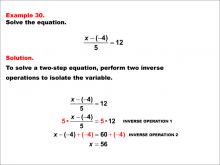
|
Math Example: Solving Two-Step Equations: Example 30 | Math Example: Solving Two-Step Equations: Example 30TopicSolving Equations DescriptionThis math example illustrates the process of solving the equation (x - (-4)) / 5 = 12. The solution involves first multiplying both sides by 5 to isolate the expression x - (-4), then subtracting -4 to isolate x. The final result is x = 56. This example demonstrates how to handle fractions and double negatives in two-step equations. |
Solving Two-Step Equations |